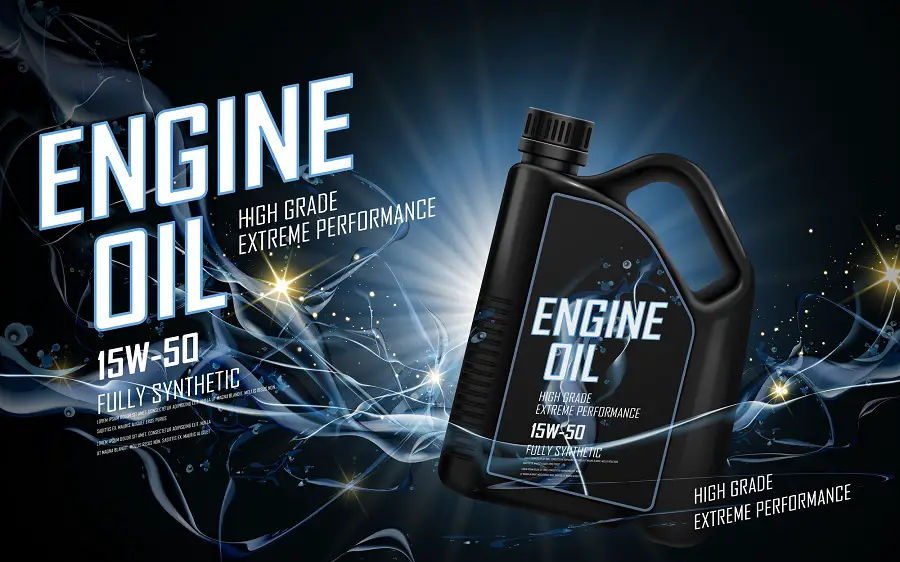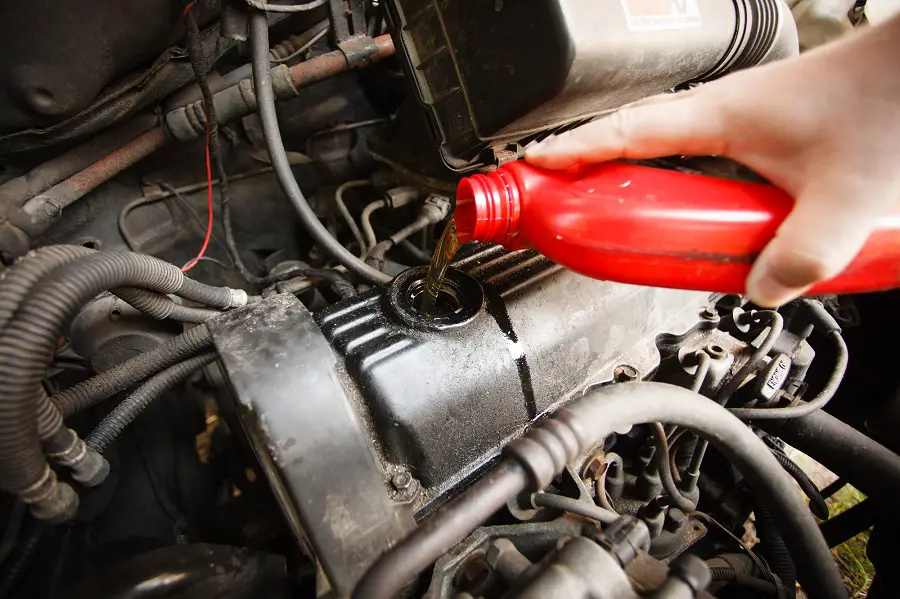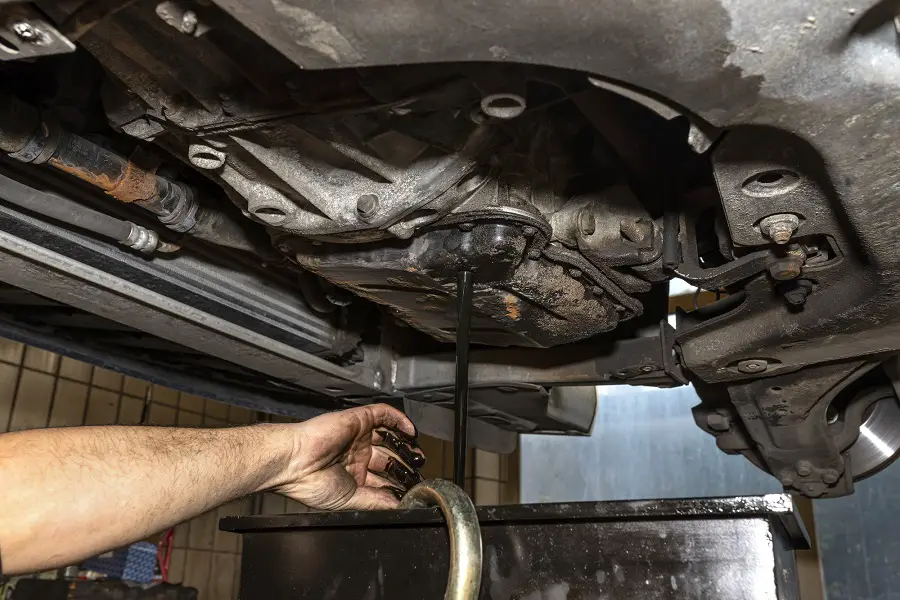Uh oh. Even if you don’t know much about cars, you know that this is a problem.
Metal shavings in my oil aren’t something I’ve experienced… yet.
But you never know. It may happen sometime. But I hope not soon – or ever.
It did happen recently to my brother. He gave me a call and said that his oil change center said he had some metal shavings in his oil and asked me what I thought about it.
Here’s what I told him:
Metal shavings in your oil can indicate serious engine damage and pending failure. Your piston rings, cylinders, oil pump, camshaft, rods and other moving parts have very narrow tolerances. If they start making contact, you will usually get metal shavings in your oil and oil filter. It should be checked out.
As you can see, there are a few different things that can be “shaving” metal from each other which will cause the problem my friend saw. Let’s figure out how to spot metal flakes in your oil, what can cause it and how to fix it.
Is It A Bad Thing if You Find Metal in Your Oil?
While having a lot of metal shavings in your motor oil is rare, it can be dangerous to the livelihood of your engine.
As engines work and rotate, they may scrape against other parts, especially if your machine is not well lubricated. This can cause grinding, resulting in shavings or filings in motor oil.
A car engine typically rotates at a speed of 2,000–3,000 RPM, though some kinds, like racing motorcycle engines, can spin at more than 20,000 RPM.
Proper lubrication lowers the resistance and friction of the engine’s rotating parts, helping greatly to lower scraping and overheating in a variety of machines.
However, friction in an engine is inevitable, so car engines are equipped with oil filters and drain plugs to catch shavings and other contaminants as they are formed and as they circulate.
Because of this, metal shavings in your oil are not necessarily harmful unless in high quantities. If the buildup of these metallic particles causes any lasting complications, they can be expensive to repair.
What Problems Can It Cause?
What are some of the signs that you may have a soon-to-fail engine and what are some of the signs that result in metal shavings? In other words, how can you know what’s wrong with your motor if you see metal particles in your oil?
Clunking or Ticking Sounds
You may be able to notice if metal shavings end up inside your engine or other moving parts by the noises it can make.
A small amount of swarf can cause ticking noises when flowing from one oil channel to another. A large amount of swarf can cause uneven fuel burning, which results in clunking noises from the engine.
Worsened Car Performance
A buildup of metal swarf will cause noticeable performance issues, such as reduced engine power when trying to accelerate.
You may notice resistance when pressing the gas pedal. In addition, shavings will cause more friction between engine parts, which sometimes results in shaking, vibrating, or rough idling.
Other Damages
Metal shavings can also cause physical damages, such as scratches on engine components. A buildup can cause blockages, resulting in lower oil pressure, stuck engine components, and sometimes engine failure.
If you see white smoke or fumes coming from your exhaust, seek a repair immediately and be very careful when operating the vehicle.
How Do They Get There (What’s The Issue)?
1. Your Car Needs An Oil Change
It is worth noting that your car is bound to have at least a small amount of metal shavings in its motor oil unless you recently changed it.
This happens naturally as the engine parts move and is not dangerous unless large amounts of metal shavings are present. Regularly getting an engine oil change will prevent unsafe amounts of metal flakes from persisting in your car’s oil over time.
2. Your Car Needs An Oil Filter Replaced
All modern automobiles are equipped with oil filters, which separate contaminants like metal shavings from engine oil.
An oil filter sustains damage over time which could result in rupture. Regularly replacing your car’s oil filter is an essential part of an oil change and preventing shavings from going where they do not belong.
However, not all oil filters work as intended. Depending on the size of the metal debris, your car’s disposable oil filter may not catch every particle.
If you have noticed the symptoms of metal swarf buildup but don’t see any shavings caught in the filter, it could be that they are microscopic metal particles and are too small for the filter to catch.
Many modern filter models are also magnetic and come with a magnetic drain plug. However, these can also experience normal wear over time and may need replacement.
Not all types of metal swarf are magnetic, so these may not be entirely effective depending on the source of the shavings.
3. Your Car Has Sustained Bearing Damage
Engine bearings are metal sleeves that assist the movement of your car’s engine. Bearings are often supplemented by multiple low-friction metals such as brass and copper.
They are held tightly in place by braces called bearing backings, usually made of materials like steel. A bearing or backing that has sustained damages may scrape and cause metal shavings.
Over time, any bearings can sustain damage, including the camshaft bearings, wrist pin bearings, and rod bearings.
A worn bearing or backing is the most common source of a buildup of metal shavings in motor oil. Such issues may indicate a bad engine build or improper assembly.
How Much Is Too Much?
Having a small amount of these filings is not usually problematic and can be solved with an oil change, but the accumulation of metal shavings in oil can cause lasting damage to your vehicle.
Once these filings have built up enough to be visible to the naked eye, there are too many metal shavings in your oil, making it an issue.
How Do I Find Out If I Have Metal In My Oil?
1. Listen And Watch For The Symptoms
Knocking and ticking sounds, white smoke, and poorer car performance are the most reliable indicators of a significant metal buildup in your engine oil.
The presence of these symptoms may indicate an engine failure, which may be costly to repair. If you’re worried about preventing the issue, consult the following steps.
2. Check Your Check Engine Light or Oil Pressure Gauge
Your dashboard engine light may be a warning sign about the contents of your oil. If you cannot identify what is causing the light, it may be that pieces of metal too small to be seen are contaminating your oil.
Your car may also be equipped with an oil pressure gauge. If it is registering an oil pressure warning, this could be the fault of metal shavings. You may also see a general service warning or oil change reminder.
3. Check Your Oil Filter
Your oil filter or oil drain plug may have caught small metal flakes. Using a magnet, you may notice a silvery sludge accumulating. However, depending on the root cause, these flakes may be non-magnetic. In addition, the metallic particles may be difficult to see or even microscopic.
4. Drop And Examine Your Oil Pan
While removing the oil pan isn’t necessary to perform an oil change, it is one of the closest parts to your engine bearings. Removing the oil pan temporarily may allow you to inspect the bearings for damage without having to remove the engine entirely. Note that this does vary by car model.
5. Get Your Car’s Oil Analyzed
If there are no visible shavings, but your car is still experiencing the symptoms of metal buildup, you may need to have your car’s oil analyzed by a mechanic or technician.
They will be able to determine the composition of the metal, which will indicate which engine component is causing the issue.
How To Diagnose The Cause And Fix the Problem
You can determine the root cause of the issue by examining the composition of the metal flakes.
For instance, most vehicle bearings are made of a combination of aluminum, copper, and steel. If your oil or the flakes have a coppery sheen, it will be easy to pinpoint the exact cause.
If the flakes are non-magnetic, they are likely aluminum shavings; if they are magnetic, they are likely steel.
Once the problematic bearing part has been identified, it simply needs replacing, which will be far more cost-effective than a total engine repair.







